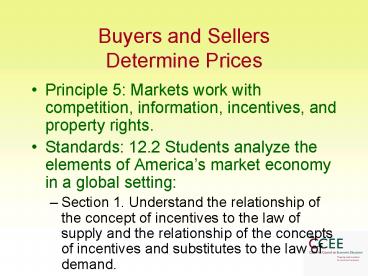Buyers and Sellers Determine Prices
1 / 35
Title:
Buyers and Sellers Determine Prices
Description:
... lowest possible price, but.... For. Sale. DEMAND. Price ... Supply price. The lowest price that a seller is willing and able to accept for a particular ... – PowerPoint PPT presentation
Number of Views:40
Avg rating:3.0/5.0
Title: Buyers and Sellers Determine Prices
1
Buyers and Sellers Determine Prices
- Principle 5 Markets work with competition,
information, incentives, and property rights. - Standards 12.2 Students analyze the elements of
Americas market economy in a global setting - Section 1. Understand the relationship of the
concept of incentives to the law of supply and
the relationship of the concepts of incentives
and substitutes to the law of demand.
2
Buyers and Sellers Determine Prices
- Standards 12.2 Students analyze the elements of
Americas market economy in a global setting - Section 4. Explain how prices reflect the
relative scarcity of goods and services and
perform the allocative function in a market
economy.
3
Goals of Buyers and Sellers
- BUYERS
- Make a transaction
- Zero price
- SELLERS
- Infinite Price
- Make a transaction
4
The Process of Price Determination
5
COMPETITION IS THE REGULATOR
- It constrains buyers and sellers.
6
Competition is the Regulator
- If he charges too much for his wares, or if
he refuses to pay as much as everybody else for
his workers, he will find himself without buyers
in the one case, and without workers in the
other.
7
Buyers want the lowest possible price, but....
DEMAND
8
they have to compete against all other buyers.
9
Sellers want to charge the highest price
possible, but ......
Supply
10
they have to compete against all other sellers.
Supply
11
Competition determines the Equilibrium Price
SUPPLY
Demand
12
How are prices determined?
- Buyers competing against each other drive the
price up - Sellers competing against each other drive the
price down - Equilibrium Price is determined by the impersonal
forces of supply and demand
13
About the buyers
14
Influences on the sellers
15
Reservation Prices
- Sellers
- Supply price
- The lowest price that a seller is willing and
able to accept for a particular quantity of a
particular product - Buyers
- Demand price
- The highest price that a buyer is willing and
able to pay for a particular quantity of a
particular product
16
At the equilibrium price
- Buyers who are able and willing to pay the price
get the goods and services they desire - Sellers who are able to produce at that price
sell all that they wish - There are neither surpluses nor shortages
- Not all prospective buyers or sellers are
satisfied
17
Relative Prices
Income 30,000
40
10
20
18
Relative Prices Have Not Changed
Income 30,000
Income 60,000
40
80
10
20
20
40
19
Supply a relationship
20
The Law of Supply
- Once all other factors have been considered, the
quantity supplied of a product varies directly
with the price of the product. - If the price rises, the quantity supplied will
rise if the price falls, the quantity supplied
will fall.
21
Demand a relationship
22
The Law of Demand
- Once all other factors have been considered, the
quantity demanded of a product varies inversely
with the price of the product. - If the price rises, the quantity demanded will
fall if the price falls, the quantity demanded
will rise.
23
Price Elasticity of Demand
- Measure of the strength of buyers reactions to
price changes - If buyers dont react very strongly, inelastic
- If buyers react strongly, elastic
24
Determinants of Price Elasticity of Demand
- availability of substitutes
- percentage of income
- time
25
Price Elasticity of Supply
- Strength of sellers response to price change
- Determinants
- time
- use of easily transferable resources
- divisibility of inputs.
26
Equilibrium Price and Quantity Exchanged
27
The Equilibrium Price
- Quantity supplied equals quantity demanded
- No shortages or surpluses
- The market clears
- Scarcity is not eliminated
- The measure of relative scarcity
28
Relative Price unit by which we measure relative
scarcity scarcity(Units on the Scarcometer)
29
Rank the relative scarcity
- PDUHs eyeballs
- Uncle Sam
- High School Musical
30
Order these products in terms of relative scarcity
- yacht
- candy bar
- dinner for one at MacDonalds
- a nice dinner for two in LA
- laptop computer
- Toyota mini truck
- ticket to a professional baseball game
31
Main Points
- The Law of Demand states that a higher price will
cause a decrease in the quantity demanded and a
lower price will cause an increase in the
quantity demanded. - A demand schedule is a relationship between
prices and quantities demanded.
32
Main Points
- The Law of Supply states that a higher price will
cause an increase in the quantity supplied and a
lower price will cause a decrease in the quantity
supplied. - A supply schedule is a relationship between
prices and quantities supplied.
33
Main Points
- Price elasticity of demand is the strength of the
buyers response to price changes. - The determinants of price elasticity of demand
are availability of substitutes, percentage of
income, and time.
34
Main Points
- Price elasticity of supply is the measure of the
strength of sellers response to a price change - The determinants of price elasticity of supply
are time, use of easily transferable resources,
and divisibility of inputs.
35
Main Points
- Buyers and sellers (demand and supply) determine
equilibrium price and quantity exchanged. - At the equilibrium price, the number of items
that sellers are willing and able to offer for
sale equals the number of items that buyers are
willing and able to purchase. - Relative scarcity is the relationship of supply
and demand. - Price is the measure of relative scarcity































